Sustainable Development Goal 14
Conserve and sustainably use the oceans, seas and marine resources
Sustainable Development Goal 14 is to “conserve and sustainably use the oceans, seas, and marine resources for sustainable development,” according to the United Nations.
The visualizations and data below present the global perspective on where the world stands today and how it has changed over time.
The UN has defined 10 targets and 10 indicators for SDG 14. Targets specify the goals and indicators represent the metrics by which the world aims to track whether these targets are achieved. Below we quote the original text of all targets and show the data on the agreed indicators.
List of targets and indicators
Target 14.1Reduce marine pollution
SDG Indicator 14.1.1Reduce marine pollution
Definition of the SDG indicator: Indicator 14.1.1 is the “(a) index of coastal eutrophication; and (b) plastic debris density” in the UN SDG framework.
Target: “Prevent and significantly reduce marine pollution of all kinds, in particular from land-based activities, including marine debris and nutrient pollution” by 2025.
Unlike most SDGs, which are set for the year 2030, this indicator is targeted for 2025.
More research: Further data and research on marine pollution can be found on the Our World in Data topic page on plastic pollution.
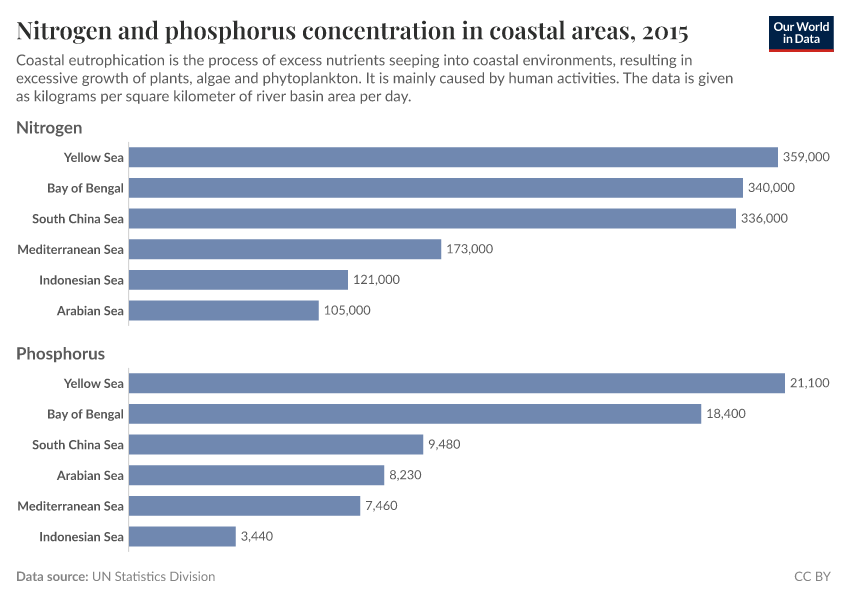
Target 14.2Protect and restore ecosystems
SDG Indicator 14.2.1Protect and restore ecosystems
Definition of the SDG indicator: Indicator 14.2.1 is the “number of countries using ecosystem-based approaches to managing marine areas” in the UN SDG framework.
Countries who have implemented ecosystem-based approaches to managing marine areas are shown in the interactive visualization.
Target: “Sustainably manage and protect marine and coastal ecosystems to avoid significant adverse impacts, including by strengthening their resilience, and take action for their restoration in order to achieve healthy and productive oceans” by 2020.
Unlike most SDGs, which are set for the year 2030, this indicator was targeted for 2020.

Target 14.3Reduce ocean acidification
SDG Indicator 14.3.1Reduce ocean acidification
Definition of the SDG indicator: Indicator 14.3.1 is the “average marine acidity (pH) measured at agreed suite of representative sampling stations” in the UN SDG framework.
The interactive visualization reports trends in the mean seawater pH, measured at the Aloha station in Hawaii. A pH of less than 7 means that a substance is acidic, lower values indicate greater acidity.
Ocean acidification is a consequence of increasing carbon dioxide emissions. Ocean water and carbon dioxide combine to form carbonic acid, as there is more carbon dioxide produced through emissions more gets absorbed by the ocean.
Target: “Minimize and address the impacts of ocean acidification, including through enhanced scientific cooperation at all levels” by 2030.
More research: More research and data on the impacts of climate change can be found in the Our World in Data climate change impacts data explorer.
Target 14.4Sustainable fishing
SDG Indicator 14.4.1Fish stocks within sustainable levels
Definition of the SDG indicator: Indicator 14.4.1 is the “proportion of fish stocks within biologically sustainable levels” in the UN SDG framework.
Fish stocks are classified as "within biologically sustainable levels" if their abundance is estimated to be equal to or greater than the level that can produce the Maximum Sustainable Yield (MSY). The MSY is the largest long-term average catch that can be taken from a fish stock under prevailing environmental and fishery conditions.
Fish stocks become overexploited when fish are caught at a rate higher than the population can support and the ability of the stock to produce its MSY is jeopardized.
Target: “By 2020, effectively regulate harvesting and end overfishing, illegal, unreported and unregulated fishing and destructive fishing practices and implement science-based management plans, in order to restore fish stocks in the shortest time feasible, at least to levels that can produce maximum sustainable yield as determined by their biological characteristics.”
Unlike most SDG targets, which have a target year of 2030, this indicator is set to be achieved by 2020.
More research: Further data and research on fisheries can be found at the Our World in Data topic page on fish and overfishing.
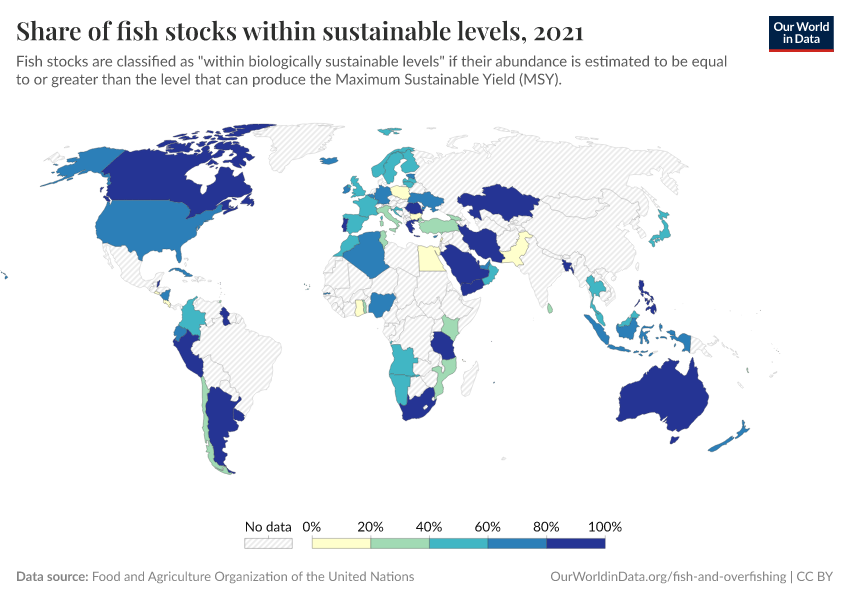
Target 14.5Conserve coastal and marine areas
SDG Indicator 14.5.1Protected marine areas
Definition of the SDG indicator: Indicator 14.5.1 is the “coverage of protected areas in relation to marine areas” in the UN SDG framework.
Target: By 2020 “conserve at least 10 per cent of coastal and marine areas, consistent with national and international law and based on the best available scientific information.”
Unlike most SDG targets, which have a target year of 2030, this indicator was set to be achieved by 2020.
Additional charts
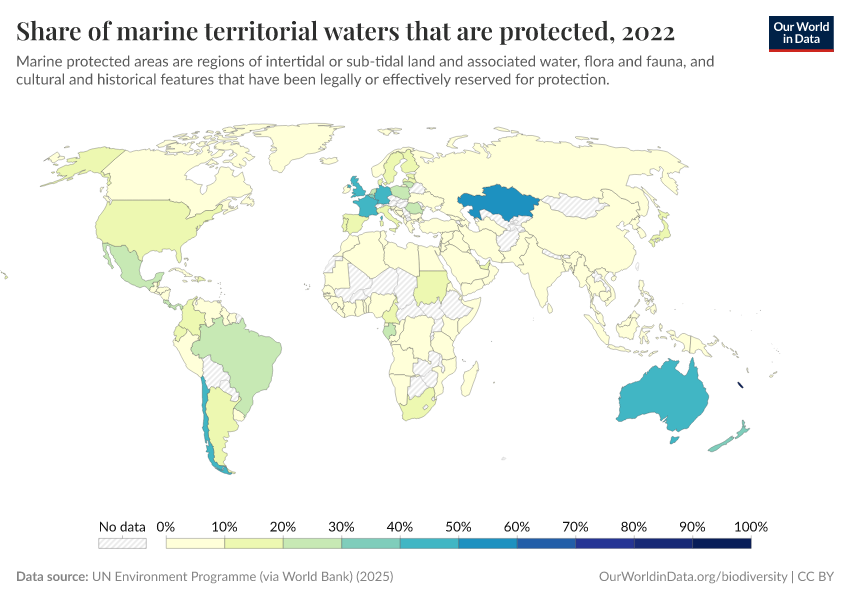
Target 14.6End subsidies contributing to overfishing and illegal fishing
SDG Indicator 14.6.1Combat illegal, unreported and unregulated fishing
Definition of the SDG indicator: Indicator 14.6.1 is “the degree of implementation of international instruments aiming to combat illegal, unreported and unregulated fishing” in the UN SDG framework.
Data for this indicator is shown in the interactive visualization.
Target: “Prohibit certain forms of fisheries subsidies which contribute to overcapacity and overfishing, eliminate subsidies that contribute to illegal, unreported and unregulated fishing and refrain from introducing new such subsidies” by 2020. 1
Unlike most SDGs, which are set for the year 2030, this indicator was targeted for 2020.
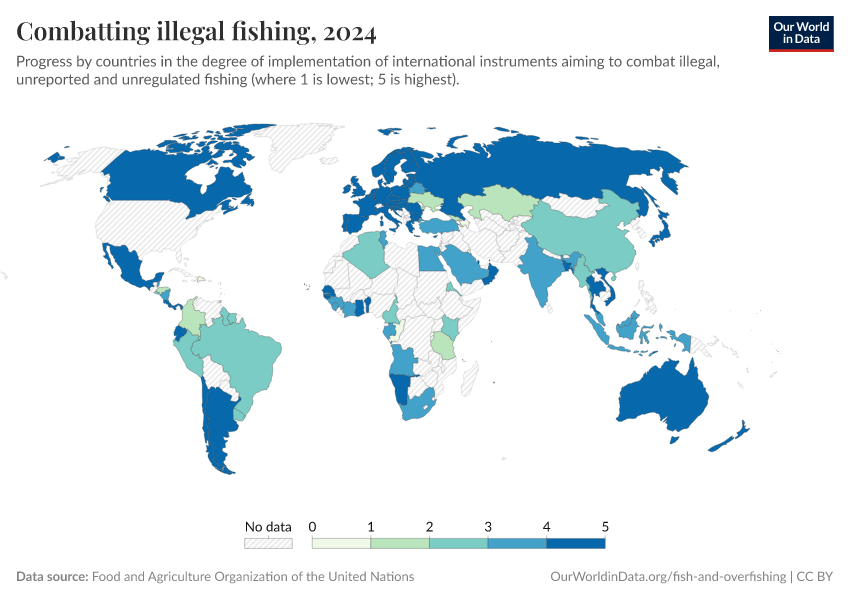
Target 14.7Increase the economic benefits from sustainable use of marine resources
SDG Indicator 14.7.1Income from sustainable fisheries
Definition of the SDG indicator: Indicator 14.7.1 is “Sustainable fisheries as a proportion of GDP in small island developing States, least developed countries and all countries” in the UN SDG framework.
The value added of marine capture fisheries indicates the prominence of marine fish related activities in the country’s economy and its importance for livelihoods. Stocks that are fished at sustainable levels are able to support the communities and industries which rely on them, without compromising reproduction and long-term sustainability. By contrast, a stock that is exploited to a point where it cannot replenish itself will ultimately provide sub-optimal long-term economic returns for stakeholders.
Data for this indicator is shown in the interactive visualization.
Target: By 2030 “increase the economic benefits to small island developing States and least developed countries from the sustainable use of marine resources, including through sustainable management of fisheries, aquaculture and tourism.”
More research: Further data and research on fisheries can be found at the Our World in Data topic page on fish and overfishing.

Target 14.aIncrease scientific knowledge, research and technology for ocean health
SDG Indicator 14.a.1Research resources for marine technology
Definition of the SDG indicator: Indicator 14.a.1 is the “proportion of total research budget allocated to research in the field of marine technology” in the UN SDG framework.
Data for this indicator is shown in the interactive visualization.
Target: “Increase scientific knowledge, develop research capacity and transfer marine technology, in order to improve ocean health and to enhance the contribution of marine biodiversity to the development of developing countries, in particular small island developing States and least developed countries by 2030.”2
More research: Further data and research on fisheries can be found at the Our World in Data topic page on research and development.

Target 14.bSupport small scale fishers
SDG Indicator 14.b.1Support small scale fishers
Definition of the SDG indicator: Indicator 14.b.1 is the “degree of application of a legal/regulatory/policy/institutional framework which recognizes and protects access rights for small-scale fisheries” in the UN SDG framework.
Data for this indicator is shown in the interactive visualization.
Target: “Provide access for small-scale artisanal fishers to marine resources and markets” by 2030.
More research: Further data and research on fisheries can be found at the Our World in Data topic page on fish and overfishing.
Additional charts
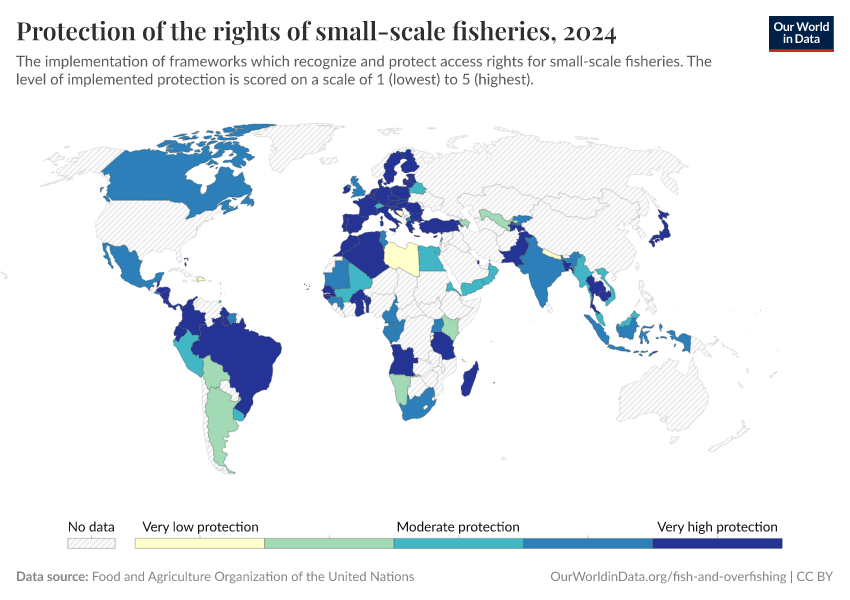
Target 14.cImplement and enforce international sea law
SDG Indicator 14.c.1Implementing international sea law
Definition of the SDG indicator: Indicator 14.c.1 is the “number of countries making progress in ratifying, accepting and implementing through legal, policy and institutional frameworks, ocean-related instruments that implement international law, as reflected in the United Nations Convention on the Law of the Sea” in the UN SDG framework.
This indicator is measured as the progress countries have made towards the ratification and accession, as well as implementation of the United Nations Convention on the Law of the Sea (UNCLOS). Note that the visualization only shows data for countries that replied to the questionnaire on the ratification, accession and implementation of UNCLOS.
Target: “Enhance the conservation and sustainable use of oceans and their resources by implementing international law as reflected in the United Nations Convention on the Law of the Sea” by 2030.3

Endnotes
Full text: “By 2020, prohibit certain forms of fisheries subsidies which contribute to overcapacity and overfishing, eliminate subsidies that contribute to illegal, unreported and unregulated fishing and refrain from introducing new such subsidies, recognizing that appropriate and effective special and differential treatment for developing and least developed countries should be an integral part of the World Trade Organization fisheries subsidies negotiation.”
Full text: “Increase scientific knowledge, develop research capacity and transfer marine technology, taking into account the Intergovernmental Oceanographic Commission Criteria and Guidelines on the Transfer of Marine Technology, in order to improve ocean health and to enhance the contribution of marine biodiversity to the development of developing countries, in particular small island developing States and least developed countries.”
Full text: “Enhance the conservation and sustainable use of oceans and their resources by implementing international law as reflected in the United Nations Convention on the Law of the Sea, which provides the legal framework for the conservation and sustainable use of oceans and their resources, as recalled in paragraph 158 of “The future we want”
Cite this work
Our articles and data visualizations rely on work from many different people and organizations. When citing this article, please also cite the underlying data sources. This article can be cited as:
Our World in Data team (2023) - “Conserve and sustainably use the oceans, seas and marine resources” Published online at OurWorldinData.org. Retrieved from: 'https://archive.ourworldindata.org/20251128-103145/sdgs/life-below-water.html' [Online Resource] (archived on November 28, 2025).BibTeX citation
@article{owid-sdgs-life-below-water,
author = {Our World in Data team},
title = {Conserve and sustainably use the oceans, seas and marine resources},
journal = {Our World in Data},
year = {2023},
note = {https://archive.ourworldindata.org/20251128-103145/sdgs/life-below-water.html}
}Reuse this work freely
All visualizations, data, and code produced by Our World in Data are completely open access under the Creative Commons BY license. You have the permission to use, distribute, and reproduce these in any medium, provided the source and authors are credited.
The data produced by third parties and made available by Our World in Data is subject to the license terms from the original third-party authors. We will always indicate the original source of the data in our documentation, so you should always check the license of any such third-party data before use and redistribution.
All of our charts can be embedded in any site.